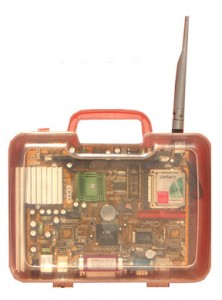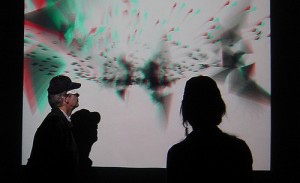Futuresonic produced its first festival in 1996, primarily celebrating the famous Manchester music scene. Over the years the festival has integrated visual and interactive works, leading to this year’s 50/50 music and media art split.

Futuresonic2004_MobileConnections21. Image by Futureeverything.
Inspired by the rapid uptake of Mobile Phones as the leading social, creative and location-based device, and in tandem with the 25th anniversary of the Technics 1200MK2 turntable, Futuresonic<04> showcased a diverse programme of club nights, conferences, workshops, performances and artworks, under the banner Mobile Connections.
The weather in Manchester was unusually glorious for this April/May weekend, making the number of attendees willing to sit in a dark conference room quite astonishing! When not absorbed in critical (and often heated) debate, delegates could wander the streets engaged in location-based interactivity.
Sonic Interface, by Japanese artist Akitsugu Maebayashi, is a simple work, installed in a backpack. As you walk it records natural acoustics – usually ignored in their over-familiar contexts – replaying them 10 seconds later. This strange de-contextualisation of recognisable sounds creates a new awareness of ‘the city’. Again inspired by the city, Streetscape by Iori Nakai uses a stylus to ‘scroll’ down Tokyo streets; you feel like an eavesdropper listening to traffic and conversations recorded at each location.
Returning to the streets of Manchester, Jen Southern & centrifugalforces collaborated on (area)code, which, like the Canadian project murmur, provides historic references to geographical locations. By texting shortcode ‘magma’ (a shop on Oldham Street), the following sms reply is received; “Oldham Street was one of Manchester’s premier late 19th & early 20th Century shopping streets”. There is no doubt that projects like these enhance awareness in locals and visitors; they are guidebooks of the future.

Futuresonic2004_MobileConnections12. Image by FutureEverything.
More chaotically, the fabulous Mobile Clubbing takes flash-mobbing a step further. A ‘Location tbc’ announcement webpage, tells the general public to take a walkman to the designated location and, quite simply, dance! Like DIY free parties (where you rang a phone number for last minute directions to the field-venue), this piece is random, unexpected, and changes perceptions of public space. It reminds me of Invisible Theatre, but without the conflict!
Highlights of the conference were Matt Adams from Blast Theory discussing the new incarnation of Uncle Roy All Around You hosted by The Cornerhouse, and the continued Creative Crossings discussions. Creative Crossings is a research consortium between Banff’s NMI, Arts Council England, and ISEA2004’s host mcult, and has a refreshing approach to social, creative, and interactive applications of location based technologies and services. If you are lucky enough to be coming to ISEA2004, we’ll continue probing aboard the cruise ship!
Futuresonic <04> was a successful, dynamic, northern event. The numbers of International artists and visitors (not to mention a few Londoners!) are a credit to the organisers and all who participated. Rather than competing with increasingly ubiquitous mobile/locative events, they sensibly involved as many as possible. Through satellite events in Berlin, San Francisco, London, Bristol, Birmingham, Liverpool, online, and continuing at ISEA2004, the extended network allows for distinction and collaboration simultaneously. Futuresonic<06> marks the 10th anniversary of the group; well done all, and roll on ISEA!
Fee Plumley
Best known for encouraging people to be creative with their mobile phones through the-phone-book Limited (UK), Fee continues to techno-evangelise as the new Digital Program Officer at the Australia Council for the Arts. Fee was the Portable Platforms & Emerging Technologies Program Manager at ANAT from 2008-2009.
Read More
http://www.futureeverything.org/
 This work is licensed under a Creative Commons Attribution-NonCommercial-ShareAlike 3.0 Australia.
This work is licensed under a Creative Commons Attribution-NonCommercial-ShareAlike 3.0 Australia.






